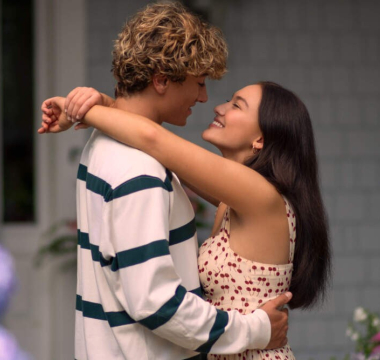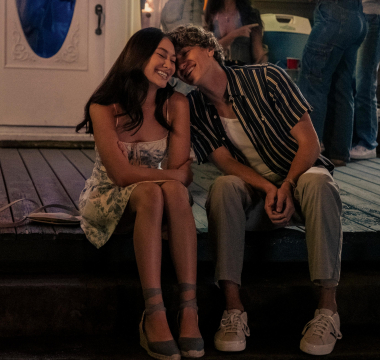The Summer I Turned Pretty Review
An In-Depth Look at "The Summer I Turned Pretty"
Having devoted many years to watching, stream, and download a plethora of films, I find it exhilarating when a movie comes along that redefines what it means to capture the essence of a coming-of-age story. "The Summer I Turned Pretty" is one such film—a delicate yet fervent exploration of youth, longing, and the transformative heat of summer. As an experienced film enthusiast with a passion for narratives that encapsulate both vulnerability and spirited exploration, I found this movie to be a refreshing departure from typical teenage romances.
From its sun-soaked cinematography to its earnest portrayal of adolescent dilemmas, the movie invites viewers not only to watch but also to immerse themselves in a beautifully layered narrative. The filmmakers have managed to blend aesthetics with substance, taking the audience on a journey through the protagonist’s internal landscape as they confront the vulnerabilities and joys of growing up. Every frame of the film serves as a testament to the subtle transitions between innocence and self-discovery, echoing the experiences of those fleeting but defining moments of transformation that mark our youth.
The Multifaceted Narrative and Visual Style
One of the central strengths of "The Summer I Turned Pretty" is its ability to tell a multi-dimensional story. The narrative is not simply a linear recounting of events; instead, it is a tapestry of emotions, relationships, and real-life transitions that help shape a young person’s understanding of love and loss. The screenplay cleverly interweaves light-hearted moments with deeper emotional undercurrents, ensuring that the experience remains as immersive as it is enlightening.
Visually, the film is a feast for the senses. The use of natural light and vivid summer hues creates an almost nostalgic atmosphere, which works in tandem with the narrative. The cinematography captures the essence of those long summer days and balmy evenings, where time seems to both stand still and accelerate all at once. Each shot is meticulously composed, drawing attention not just to the landscape but also to the subtleties of the characters’ expressions—the silent dilemmas, the tentative flirtations, and the resilient hopefulness that defines each moment.
Performances and Character Development
At its heart, this film is driven by powerhouse performances from its ensemble cast. The actor portraying the central character delivers a performance full of nuance and authenticity. This performance, defined by a careful balance of introspection and liberation, captures the magic of turning points in life. Supporting roles, equally compelling, add layers of complexity that round out the film’s emotional breadth. The chemistry between the characters brings depth to the dialogue, making even simple exchanges resonate with genuine emotion.
The character development is particularly notable. The protagonist’s journey is one of not only physical self-discovery but also emotional metamorphosis. The film delicately handles themes of unrequited love, complicated family dynamics, and the bittersweet nature of letting go. It offers viewers a chance to reflect on their own experiences, perhaps remembering moments when everything changed in an instant, forcing them to re-evaluate their identity and their place in the world. This reflective quality makes the narrative as universally relatable as it is personally inspiring.
Storytelling and Pacing
The pacing of "The Summer I Turned Pretty" is measured and deliberate, inviting audiences to ruminate on its themes rather than providing a rapid carousel of events. This slower pace is a double-edged sword—it may challenge viewers accustomed to faster cuts and high-adrenaline sequences, yet it rewards those who revel in emotional depth and character introspection. The film artfully alternates between moments of serene quietude and bursts of intense emotional dynamism.
The storytelling is layered, with subplots that extend beyond what is immediately visible on screen. The narrative does not shy away from exploring the complexity of personal growth and the sometimes tumultuous process of self-realization. It encourages viewers to consider how a single summer can serve as the catalyst for a lifetime of changes. The film also masterfully employs flashbacks and internal monologues to enrich the storyline, revealing hidden dimensions of the characters’ experiences and unspoken dilemmas.
A Visual and Auditory Feast
Besides its compelling narrative and commendable performances, the film excels in its use of visual imagery and sound. The ambient music score, which ebbs and flows with the intensity of the visuals, reinforces the film’s emotional core. Much like a classic summer anthem, the soundtrack weaves memories with mood in a way that resonates not only in the theater but also in the hearts of the viewers.
The aesthetics of the film—from its thoughtfully constructed sets to the natural environments where much of the story unfolds—speak volumes about the care taken during production. The vistas of sunlit beaches, the warmth of golden hour shots, and the spontaneous energy of summer festivals all contribute to an experience that is as visually enchanting as it is narratively rewarding. It is clear that every visual element has been calibrated to evoke the feeling of being young and alive, facing the unknown with unbridled enthusiasm and an underlying note of trepidation.
Thematic Depth and Cultural Resonance
While the film may appear, at first glance, to be a light-hearted summer romance, it also tackles broader themes of identity, transformation, and the passage of time. It is a meditation on how transient moments can have everlasting impacts on our lives. At its core, the film is an ode to the bittersweet nature of growing up—a universal theme that transcends age, geography, and cultural context.
The narrative does not simply mask the challenges of youth under a veneer of aesthetic pleasure; instead, it uses its visual brilliance to underscore the poignant struggles of self-acceptance and the courage required to change. In this way, the film strikes a delicate balance between celebration and melancholy, encapsulating the complex duality of life. Its reflective nature encourages viewers to ask themselves critical questions about their own journeys: How have the moments that once defined me evolved into the foundation of who I am today? How does one reconcile nostalgia with the inevitability of change?
Mood and Atmosphere
The ambiance of the film is one of its most arresting qualities. It captures the essence of a long, storied summer, when each day feels limitless and filled with potential. There is a palpable sense of anticipation and freedom that permeates every frame. This is accentuated by an artful blend of both warmth and melancholy—a reminder that the most influential moments can sometimes be the ones that challenge us the most.
The storytelling remains grounded in authenticity, eschewing clichés for a more genuine portrayal of growing pains and the raw beauty of human emotion. The natural light that floods each scene is not merely a cinematic technique, but a symbolic gesture toward understanding oneself in the light of day. It is as if the film itself is a metaphor for enlightenment—the clarity that comes from embracing change, even amidst inevitable heartbreak.
Narrative Techniques and Emotional Impact
A significant achievement of "The Summer I Turned Pretty" is its innovative narrative structure. The film does not rely solely on dialogue to convey its deeper meanings; it uses the interplay of imagery, sound, and silence to eloquently describe the inner workings of the human spirit. Scenes of quiet introspection are juxtaposed with sequences brimming with vivacity, creating an experiential rhythm that mirrors the unpredictable nature of life itself.
This approach is particularly effective in conveying the intricacies of the protagonist's transformation. In one memorable scene, the camera lingers on a reflection in a pool of water—a metaphor for looking into one's inner self and confronting the inevitable cycles of change. The silent exchange of glances, the hesitant smiles, and the unexpressed truths provide poignant insights into the characters' inner lives. The film challenges the viewer to peel back the layers of each personality, gradually discovering the multifaceted narratives that lie beneath.
The emotional impact of the film is profound. It manages to evoke a sense of longing that is familiar and yet difficult to articulate, stirring a remembrance of times when every fleeting moment seemed imbued with endless possibility. The film’s ability to tap into that reservoir of shared human experience transforms it from a simple narrative into a personal exploration of one’s own past, evoking memories of summer adventures, secret rendezvous, and silent struggles.
The Role of Music and Sound Design
Integral to the film’s impact is its masterful use of music and sound design. The score is crafted with a subtle yet deliberate precision, blending ambient sounds with carefully selected musical cues that enhance the film’s thematic resonance. The music is never overbearing; instead, it acts as an emotional guide, ferrying viewers from moments of intense introspection to episodes of exuberant freedom.
Sound design in "The Summer I Turned Pretty" is employed to great effect, reflecting both the inner turmoil and the elation that accompany moments of growth. The carefully orchestrated blend of dialogue, diegetic sound, and music creates an immersive soundscape that mirrors the narrative’s oscillation between joy and melancholy. This detailed sound portrait is a testament to the filmmakers’ commitment to delivering an experience that appeals to both the heart and the intellect.
Implications for Future Storytelling
In a broader context, this film stands as an example of how modern storytelling can successfully navigate complex themes without sacrificing entertainment value. It bridges the gap between conventional romantic narratives and more nuanced, character-driven dramas. There is a raw sincerity in its portrayal of teenage life—a sincerity that encourages viewers to explore their own memories and emotions as they watch the film.
Furthermore, "The Summer I Turned Pretty" challenges the conventions of youth-centric films. It places its central character in scenarios that demand emotional maturity, thereby questioning what it truly means to grow up. The film not only provides a visual feast for those who choose to watch, stream, and download it on various devices but also serves as a cultural artifact—one that will likely influence future portrayals of adolescence in cinema. Its candid examination of the highs and lows of coming of age, enriched by an impeccable blend of sound, visuals, and narrative, sets a high bar for future films in the genre.
Reflections on the Viewing Experience
For those willing to dive into the layered complexities of "The Summer I Turned Pretty," the experience is both cathartic and inspiring. It is a film that invites you to think deeply about your own life milestones while basking in the glow of exquisite summer imagery. One cannot help but feel a sense of melancholy for moments that have passed, yet also a renewed appreciation for the beauty inherent in every transition. The movie encourages viewers to watch, stream, and even download their reflections on summers gone by, all while resonating with themes that are timeless and universal.
In conclusion, "The Summer I Turned Pretty" is more than just a film—it is an ode to transformation, a celebration of human vulnerability, and an exploration of the bittersweet nature of change. Its portrayal of youth transcends the ordinary, inviting us to experience an inward journey that is as visually captivating as it is emotionally stirring. As a film enthusiast, I appreciate the unblocked exploration of themes that are often overshadowed in mainstream cinema, and I look forward to seeing how this story will continue to inspire discussions on the interplay between nostalgia and growth.
How to Watch The Summer I Turned Pretty Online
Currently, this film is available to watch on several reputable online platforms. Depending on your preference, you can stream it directly or download it for offline enjoyment. While some platforms allow you to watch the film for free through ad-supported options, others might require a subscription or rental fee. The movie holds an age rating of PG-13 in the United States, making it appropriate for teens and older audiences.
Netflix offers a convenient streaming option with a free trial for new users and the ability to download episodes for later viewing. Amazon Prime Video provides options for rent or purchase, along with offline access after download. Apple TV enables users to either rent or buy the film in high quality, with a download feature included. Meanwhile, Peacock features both free and premium tiers with varying download conditions, and Hulu offers similar streaming possibilities with trial availability and limited download functionalities. YouTube (Movies) also presents a rent or buy option, ensuring that viewers have multiple platforms to access the film.












Leave a comment
Your comment is awaiting moderation. We save your draft here
0 Comments